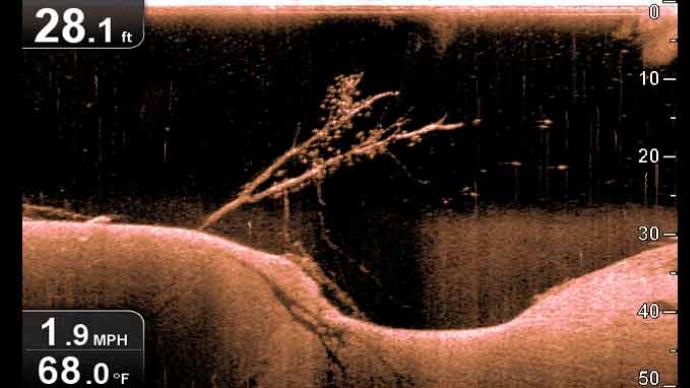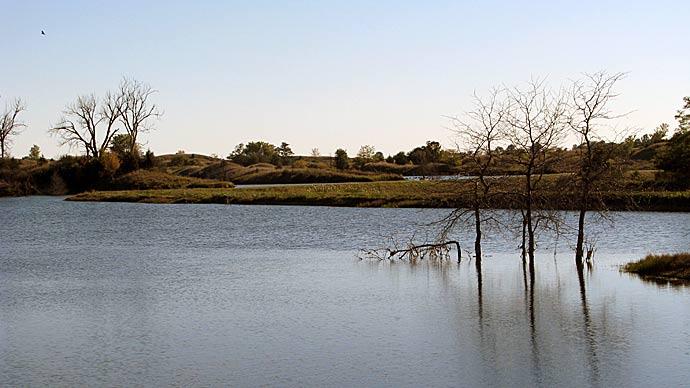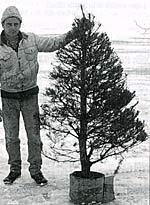
Christmas trees. Untold numbers are discarded after the holiday season each year. However, don't throw them away. They can be used to create fish habitat.
Generally speaking, Christmas tree structures are primarily used to concentrate fish for angling. Members of the sunfish family, such as largemouth bass, bluegill, and crappies are attracted to submerged trees. Small fishes hide there for protection. Larger fishes may seek protection, or may chase the small fishes that are attracted by it.
Occasionally, tree structures are added for spawning habitat. One good example involves yellow perch. If any northern readers have yellow perch in their ponds, this species likes to entangle their egg masses on submerged trees.
Two major questions arise. How to build...and how long do Christmas trees last under water?
|
Image
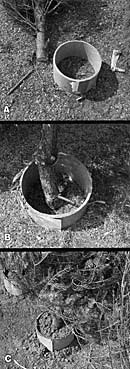
|
|
Image
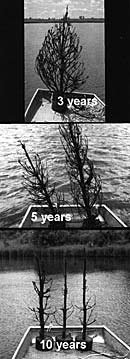
|
Various methods exist to anchor Christmas trees so they will stay submerged. Cinder, or cement blocks can anchor submerged trees. When using cement to hold a tree in one side of a block, be sure to pound a couple of nails into the tree base at a right angle to hold it in place. Otherwise, the tree may slip out of the block. One advantage of this type of structure is the tree can be placed upright to provide the desired 3-dimensional shape (length, width, and height). A disadvantage is limited size of trees you can use by the size of the opening in the block.
Be careful using rope to tie a tree to a block. If you simply tie rope to a branch, the branch can break and the rope would then slip off, allowing the tree to float. Most plastic-based ropes degrade in sunlight. Ropes do not last nearly as long as heavy wire or thin cable. A disadvantage of simply tying a block to a Christmas tree is that the tree will lie on the pond bottom rather than stand upright. After being submerged, trees waterlog and no longer float. When using this type of weighting, it probably is best to pile several trees on top of each other to get some vertical height to your structure.
This brings us nicely to the type of Christmas tree structures we currently are using.
We start by going to a carpet store, and getting 12-inch diameter cardboard tube on which carpet was rolled. Next, we cut 8-inch lengths and place them upright on the ground. We trim lower branches from a Christmas tree, drill a 5/8-inch hole through tree trunk, and drive an 11-inch length of 1/2-inch rebar through hole. Finally, we place the tree into the cardboard tube and fill with concrete. These trees are easily placed in the pond and they tend to remain upright and stable for a long time.
How to place the tree in your pond can also be an issue. Boats have been most efficient for us. We have, at times, submerged the trees through ice (yes, can you southern pond owners believe that?). However, cutting holes in the ice can be a lot of work, depending on ice thickness. Simply placing trees on ice and waiting for them to melt through does not work either, at least in the North Country. As ice melts around the edge of a lake or pond, remaining ice shifts, and structures may be deposited far from that special spot.

How long do sunken Christmas trees last? Misconceptions abound about rate of decay for waterlogged submersed trees. Most important is to completely submerge trees. Trees that are submerged, exposed, then submerged, etc., will decay MUCH faster than a tree that remains continually under water.
We took a series of photos of trees that were raised 3, 5, and 10 years after being submerged. After 3 years, needles were gone, but branches were still intact. After 5 years, a few smaller branches were gone, but the tree was still providing much habitat. After 10 years, all but the largest branches had decayed. However, the main trunk and larger branches were still functioning as a useful fish attractor.
So, consider using discarded Christmas trees as a source of habitat for your ponds. When constantly submerged, they last much longer than generally believed!
Your pond will be happy, your fish will be happy, and the human at the business end a rod bent double will be happy.
Dave Willis is a fisheries professor at South Dakota State University. He can be reached via the Pond Boss Forum at www.pondboss.com. Todd St. Sauver is the regional fisheries supervisor with the South Dakota Department of Game, Fish and Parks, stationed in Sioux Falls.
Reprinted with permission from Pond Boss Magazine


